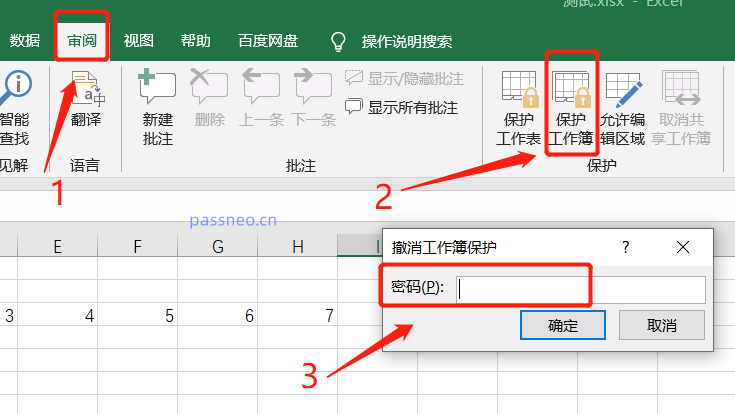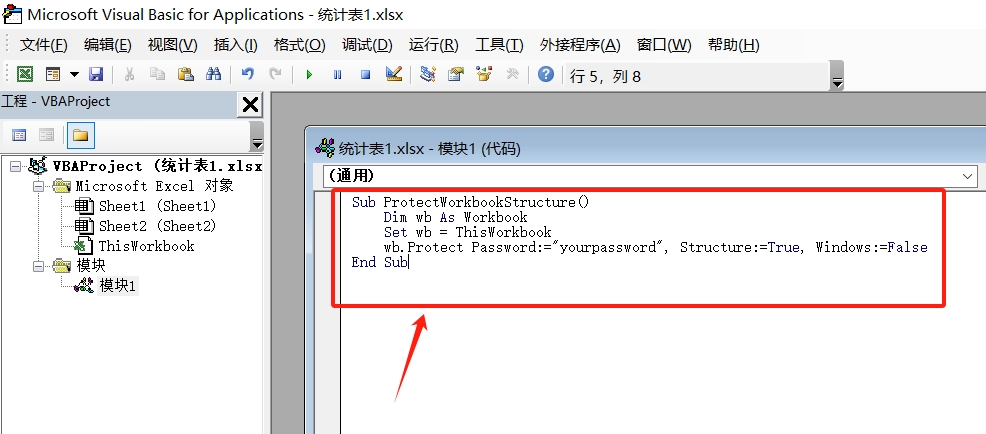 Software Tutorial
Software Tutorial
 Office Software
Office Software
 Two strategies for protecting Excel workbooks: preventing worksheets from being added, deleted or moved
Two strategies for protecting Excel workbooks: preventing worksheets from being added, deleted or moved
Two strategies for protecting Excel workbooks: preventing worksheets from being added, deleted or moved
Protect Excel workbooks from unauthorized editing When using Excel, you often need to protect the data and structure in the workbook to prevent others from making unauthorized changes. You can easily set different protection levels in Excel to meet your specific needs. This article will detail two simple methods for you to effectively protect your Excel workbook and ensure its security and integrity. Don’t miss the following content compiled by PHP editor Baicao to learn how to protect Excel workbooks to avoid accidental or malicious editing.
Method 1: Set a restricted password
Lock the Excel workbook with a password, so that only the worksheet can be added, deleted, moved or hidden by knowing the password.
Setting method
First, open the Excel workbook that needs to be protected and click "Protect Workbook" in the "Review" tab list.
In the pop-up dialog box, select the "Structure" checkbox to ensure that only the workbook structure is protected.
Then enter the password you want to set in the password field, click "Confirm" and re-enter it to set it.

After setting up, you can see that operations such as adding, deleting or moving worksheets are prohibited, which means that the workbook structure has been protected.

Cancellation method
If you need to cancel the protection of the workbook structure, follow the steps below:
In the "Review" tab, click "Unprotect Workbook". After the dialog box pops up, enter the password and click "OK", and the workbook structure protection will be cancelled.

It should be noted that after setting the password, remember to remember it or save it, because it is impossible to cancel the structure protection in Excel without a password.
If you really forget it accidentally, you need to use other tools to solve the problem. For example, PepsiNiu Excel Password Recovery Tool can directly remove the "restriction password" of the Excel workbook without a password and cancel the structure protection.
You only need to click the [Unrestriction] module in the tool, and then import the protected Excel into the tool, and you can unblock it with one click.

Method 2: Use VBA macro to protect the workbook structure
If you don’t want to set a password, you can also use VBA macro code to protect the workbook.
Setting method
1. After opening Excel, press "Alt + F11" to open the VBA editor. In the VBA editor, click the "Insert" menu and select "Module".

2. After creating a new module, enter the following code:
Sub ProtectWorkbookStructure() Dim wb As Workbook Set wb = ThisWorkbook wb.Protect Password:=”yourpassword”, Structure:=True, Windows:=FalseEnd Sub

3. Close the VBA editor, return to Excel, press "Alt + F8" to open the macro dialog box, select "ProtectWorkbookStructure", and then click "Run", the Excel workbook structure will be locked, and Begin to be protected.

Cancellation method
If you need to cancel the protection set through VBA macro, follow the steps below:
1. Call up the VBA editor according to the setting method. After creating a new module, enter the following code:
Sub UnprotectWorkbookStructure() Dim wb As Workbook Set wb = ThisWorkbook wb.Unprotect Password:=”yourpassword”End Sub

2. Close the VBA editor, return to Excel, press "Alt + F8" to open the macro dialog box, select "UnprotectWorkbookStructure", and then click "Run".
The structure protection of the Excel workbook is cancelled.

The above is the detailed content of Two strategies for protecting Excel workbooks: preventing worksheets from being added, deleted or moved. For more information, please follow other related articles on the PHP Chinese website!

Hot AI Tools

Undresser.AI Undress
AI-powered app for creating realistic nude photos

AI Clothes Remover
Online AI tool for removing clothes from photos.

Undress AI Tool
Undress images for free

Clothoff.io
AI clothes remover

Video Face Swap
Swap faces in any video effortlessly with our completely free AI face swap tool!

Hot Article

Hot Tools

Notepad++7.3.1
Easy-to-use and free code editor

SublimeText3 Chinese version
Chinese version, very easy to use

Zend Studio 13.0.1
Powerful PHP integrated development environment

Dreamweaver CS6
Visual web development tools

SublimeText3 Mac version
God-level code editing software (SublimeText3)

Hot Topics
 1666
1666
 14
14
 1426
1426
 52
52
 1328
1328
 25
25
 1273
1273
 29
29
 1253
1253
 24
24
 If You Don't Rename Tables in Excel, Today's the Day to Start
Apr 15, 2025 am 12:58 AM
If You Don't Rename Tables in Excel, Today's the Day to Start
Apr 15, 2025 am 12:58 AM
Quick link Why should tables be named in Excel How to name a table in Excel Excel table naming rules and techniques By default, tables in Excel are named Table1, Table2, Table3, and so on. However, you don't have to stick to these tags. In fact, it would be better if you don't! In this quick guide, I will explain why you should always rename tables in Excel and show you how to do this. Why should tables be named in Excel While it may take some time to develop the habit of naming tables in Excel (if you don't usually do this), the following reasons illustrate today
 How to change Excel table styles and remove table formatting
Apr 19, 2025 am 11:45 AM
How to change Excel table styles and remove table formatting
Apr 19, 2025 am 11:45 AM
This tutorial shows you how to quickly apply, modify, and remove Excel table styles while preserving all table functionalities. Want to make your Excel tables look exactly how you want? Read on! After creating an Excel table, the first step is usual
 Excel MATCH function with formula examples
Apr 15, 2025 am 11:21 AM
Excel MATCH function with formula examples
Apr 15, 2025 am 11:21 AM
This tutorial explains how to use MATCH function in Excel with formula examples. It also shows how to improve your lookup formulas by a making dynamic formula with VLOOKUP and MATCH. In Microsoft Excel, there are many different lookup/ref
 Excel: Compare strings in two cells for matches (case-insensitive or exact)
Apr 16, 2025 am 11:26 AM
Excel: Compare strings in two cells for matches (case-insensitive or exact)
Apr 16, 2025 am 11:26 AM
The tutorial shows how to compare text strings in Excel for case-insensitive and exact match. You will learn a number of formulas to compare two cells by their values, string length, or the number of occurrences of a specific character, a
 How to Make Your Excel Spreadsheet Accessible to All
Apr 18, 2025 am 01:06 AM
How to Make Your Excel Spreadsheet Accessible to All
Apr 18, 2025 am 01:06 AM
Improve the accessibility of Excel tables: A practical guide When creating a Microsoft Excel workbook, be sure to take the necessary steps to make sure everyone has access to it, especially if you plan to share the workbook with others. This guide will share some practical tips to help you achieve this. Use a descriptive worksheet name One way to improve accessibility of Excel workbooks is to change the name of the worksheet. By default, Excel worksheets are named Sheet1, Sheet2, Sheet3, etc. This non-descriptive numbering system will continue when you click " " to add a new worksheet. There are multiple benefits to changing the worksheet name to make it more accurate to describe the worksheet content: carry
 Don't Ignore the Power of F4 in Microsoft Excel
Apr 24, 2025 am 06:07 AM
Don't Ignore the Power of F4 in Microsoft Excel
Apr 24, 2025 am 06:07 AM
A must-have for Excel experts: the wonderful use of the F4 key, a secret weapon to improve efficiency! This article will reveal the powerful functions of the F4 key in Microsoft Excel under Windows system, helping you quickly master this shortcut key to improve productivity. 1. Switching formula reference type Reference types in Excel include relative references, absolute references, and mixed references. The F4 keys can be conveniently switched between these types, especially when creating formulas. Suppose you need to calculate the price of seven products and add a 20% tax. In cell E2, you may enter the following formula: =SUM(D2 (D2*A2)) After pressing Enter, the price containing 20% tax can be calculated. But,
 I Always Name Ranges in Excel, and You Should Too
Apr 19, 2025 am 12:56 AM
I Always Name Ranges in Excel, and You Should Too
Apr 19, 2025 am 12:56 AM
Improve Excel efficiency: Make good use of named regions By default, Microsoft Excel cells are named after column-row coordinates, such as A1 or B2. However, you can assign more specific names to a cell or cell range, improving navigation, making formulas clearer, and ultimately saving time. Why always name regions in Excel? You may be familiar with bookmarks in Microsoft Word, which are invisible signposts for the specified locations in your document, and you can jump to where you want at any time. Microsoft Excel has a bit of a unimaginative alternative to this time-saving tool called "names" and is accessible via the name box in the upper left corner of the workbook. Related content #
 Why You Should Always Rename Worksheets in Excel
Apr 17, 2025 am 12:56 AM
Why You Should Always Rename Worksheets in Excel
Apr 17, 2025 am 12:56 AM
Improve Excel’s productivity: A guide to efficient naming worksheets This article will guide you on how to effectively name Excel worksheets, improve productivity and enhance accessibility. Clear worksheet names significantly improve navigation, organization, and cross-table references. Why rename Excel worksheets? Using the default "Sheet1", "Sheet2" and other names is inefficient, especially in files containing multiple worksheets. Clearer names like “Dashboard,” “Sales,” and “Forecasts,” give you and others a clear picture of the workbook content and quickly find the worksheets you need. Use descriptive names (such as "Dashboard", "Sales", "Forecast")



